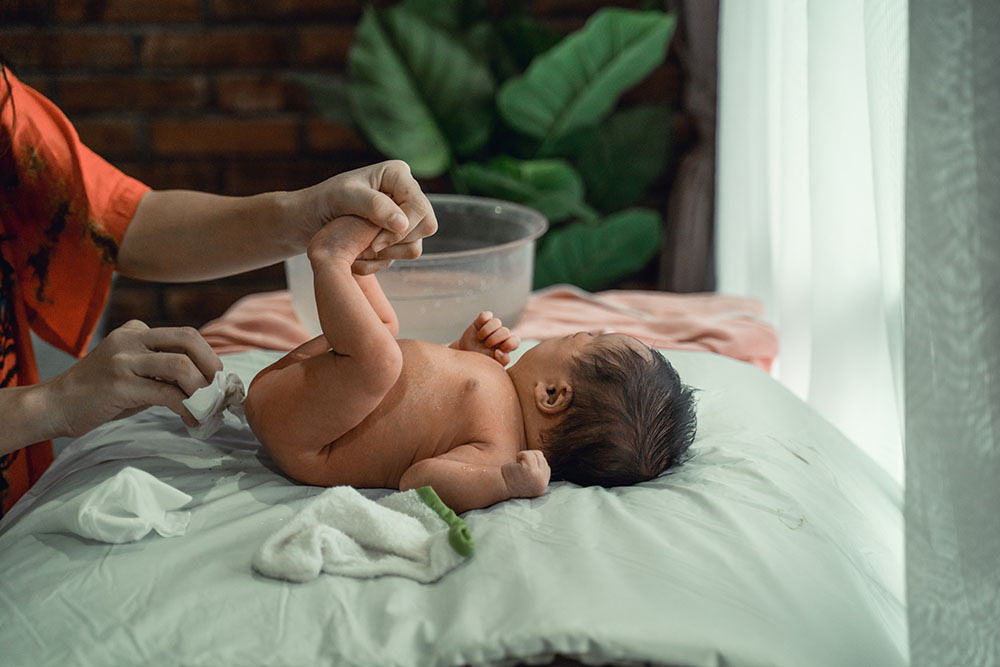The Scoop on Baby Poop

You’ve paid your doos, er, dues in days of yore—changed diapers for your nephew, friends’ kids and those sweet twins you babysat. Although you might recall the scent and the struggle (those wee ones can wiggle!), you likely blocked out what was in them. Now that you’re a mama, you’ll want to pay closer attention to what awaits you during diaper duty and what it means for your baby’s health.
In the Beginning
Meconium is your baby’s first bowel movement. It’s the substance that has been building in her intestines in utero. A mixture of amniotic fluid, bile and mucus, it is sticky, tarry and dark green, as you’ll see soon enough. It’s generally passed within her first 12 hours of life, though it can take up to 24 hours. Your pediatrician should be contacted if it takes any longer as it could signal an intestinal obstruction.
This first phase occurs in the first days of life while her system is being cleared out as she feeds on your colostrum. Your “first milk” acts as a laxative during this time and helps the meconium to pass, letting you know that her bowels are healthy and working properly.
On the Boob
If you are breastfeeding, babe’s stool will graduate to a mustard yellow. It tends to be grainy, runny and sometimes mistaken for diarrhea. Breastfed babies generally have more bowel movements than formula fed babies. Their stool also tends to be less offensive in smell and has even been described as sweet—that breast milk really is magical.
Don’t be shocked if you are changing your baby’s diaper after every feeding, but also don’t be concerned if she only goes once or twice a day. This is perfectly normal as she and her moving parts are getting acquainted.
On the Bottle
If you’re formula feeding, you’ll still have your fair share of diaper changes. On average, your little one should go at least once a day so that her digestive system doesn’t get backed up. Though she’s unlikely to have a bowel movement after every feeding, she could potentially have up to four or five a day. Overall, if she’s bottle-fed she won’t go as much as if she were breastfed because she’s not absorbing as many nutrients. The stool will also be thicker than if she is breastfed, but should not be much harder than the consistency of peanut butter. It also smells more like adult stool and is generally yellow-brown or light yellow in color.
Do Me a Solid
As solid foods are introduced, her poop will become more uniform and often contain undigested bits until her system gets used to the change in consistency. The color will depend on what she eats. Baby’s stool will also become thicker, darker and—shocker—smellier.
As the ol’ saying goes: sh*t happens. Remember not to drive yourself crazy over-analyzing or comparing every dirty diaper. Your newborn baby is getting used to how everything works. As long as she is gaining weight and staying healthy, changes in infant poop are perfectly acceptable. Who would’ve thought you’d be tracking bowel movements or that they could make you so happy? Welcome to that new mom life.
The Many Hues of Poo and What They Signal
Green: Good to Go
In your early nursing days, the fast let-down may cause your milk to go through babe’s system faster than usual. Once your milk flow becomes richer and she gets used to it, the stool color should be a normal yellowish. Formula can produce green poops because of the iron it contains. As long as your newbie isn’t constipated*, it’s normal.
Signs of constipation to recognize:
- Hard, loose stools
- Swollen, tight tummy
- Less bowel movements than normal
Yellow: Mellow Yellow
You can rest easy because this sunny hue is normal for both bottle-fed and breastfed infants.
Red: Proceed with Caution
Although it’s not an immediate cause for alarm if the baby’s poop contains a little blood at some point, you should remain observant of how often it occurs. Small strains of blood may be caused by small cuts or fissures on the anus due to straining or diaper rash. If the poop has mucous strains or jelly-like blood, contact your baby’s doctor right away.
White: Something is Missing
White poop can mean that babe has no bile from the liver to digest food. Although you shouldn’t be white with fright, a call to your healthcare provider should be made.







